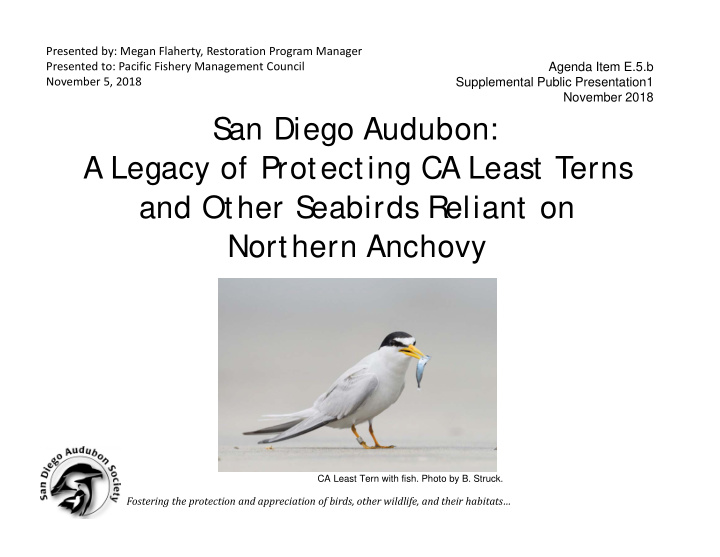



Presented by: Megan Flaherty, Restoration Program Manager Presented to: Pacific Fishery Management Council Agenda Item E.5.b November 5, 2018 Supplemental Public Presentation1 November 2018 S an Diego Audubon: A Legacy of Protecting CA Least Terns and Other S eabirds Reliant on Northern Anchovy CA Least Tern with fish. Photo by B. Struck. Fostering the protection and appreciation of birds, other wildlife, and their habitats…
Presentation Outline • Introduction to San Diego Audubon Society (SDAS) • Conservation of the CA Least Tern in Mission Bay • Importance of Anchovy • Asks of the PFMC California Least Tern. Photo: W. Dalton Fostering the protection and appreciation of birds, other wildlife, and their habitats…
Intro to SDAS: Mission and Vision • Foster the protection and appreciation of birds, other wildlife, and their habitats • Inspire a culture of conservation where people appreciate, California Least Tern, with eggs. Photo: N. Johnston understand, and actively protect the natural world Fostering the protection and appreciation of birds, other wildlife, and their habitats…
About San Diego Audubon • Programs: – Education – Sanctuaries – Outreach – Conservation Volunteers clearing coastal dune habitat. Photo: SDAS Fostering the protection and appreciation of birds, other wildlife, and their habitats…
California Least Tern (CLTE) • Sterna antillarum browni • Small, grey, migratory seabird • Winter: Central America Nest: CA Coast • Forage for anchovies in lagoons, offshore water CA least tern in Mission Bay • Foraging time = highly Photo: B. Struck sensitive to predation Fostering the protection and appreciation of birds, other wildlife, and their habitats…
CLTE Conservation Status • State and federally ‐ listed endangered (1970) • Nesting pairs/fledges avg: – 2000 ‐ 2004: 400/125 – 2005 ‐ 2009: 200/14 – 2010 ‐ 2015: 197/57 • Threats: Human disturbance, veg cover, California Least Tern feeding chick. Photo: S. Nelson ‐ Embry predation, food availability Fostering the protection and appreciation of birds, other wildlife, and their habitats…
Habitat Restoration • Remove invasive weeds, install signs, repair fencing • Benefits multiple species • 1,000+ volunteers every year
Ternwatchers • Volunteer predator monitoring program • Record sightings of predators and contact predator control when needed • Since kicking off in 2014, over 100 volunteers have SDAS staff and Ternwatcher volunteers at Mariner’s Point. Photo: Katie Schoolov donated nearly 2,000 hours Fostering the protection and appreciation of birds, other wildlife, and their habitats…
Decline in Anchovy...
...Appears to be Affecting Nesting Productivity • Point Blue Conservation Science ‐ northern anchovy decreasing near CLTE colonies in Sothern CA • Switch to fish larva and less nutritious food sources Least Tern feeding chick. Photo by S. Nelson ‐ Embry • Nesting productivity goes down
Need for Ecosystem ‐ based Management • Eliminate the Monitored Stock category • Same features and updates as Active Stock • Stock assessments • Respond to fluctuations in population size • Protect spawning areas • Use science ‐ based catch limits
Brown Pelican. Photo by John Menard. Humpback Whale. Photo by: Anite Ritenour
Recommend
More recommend